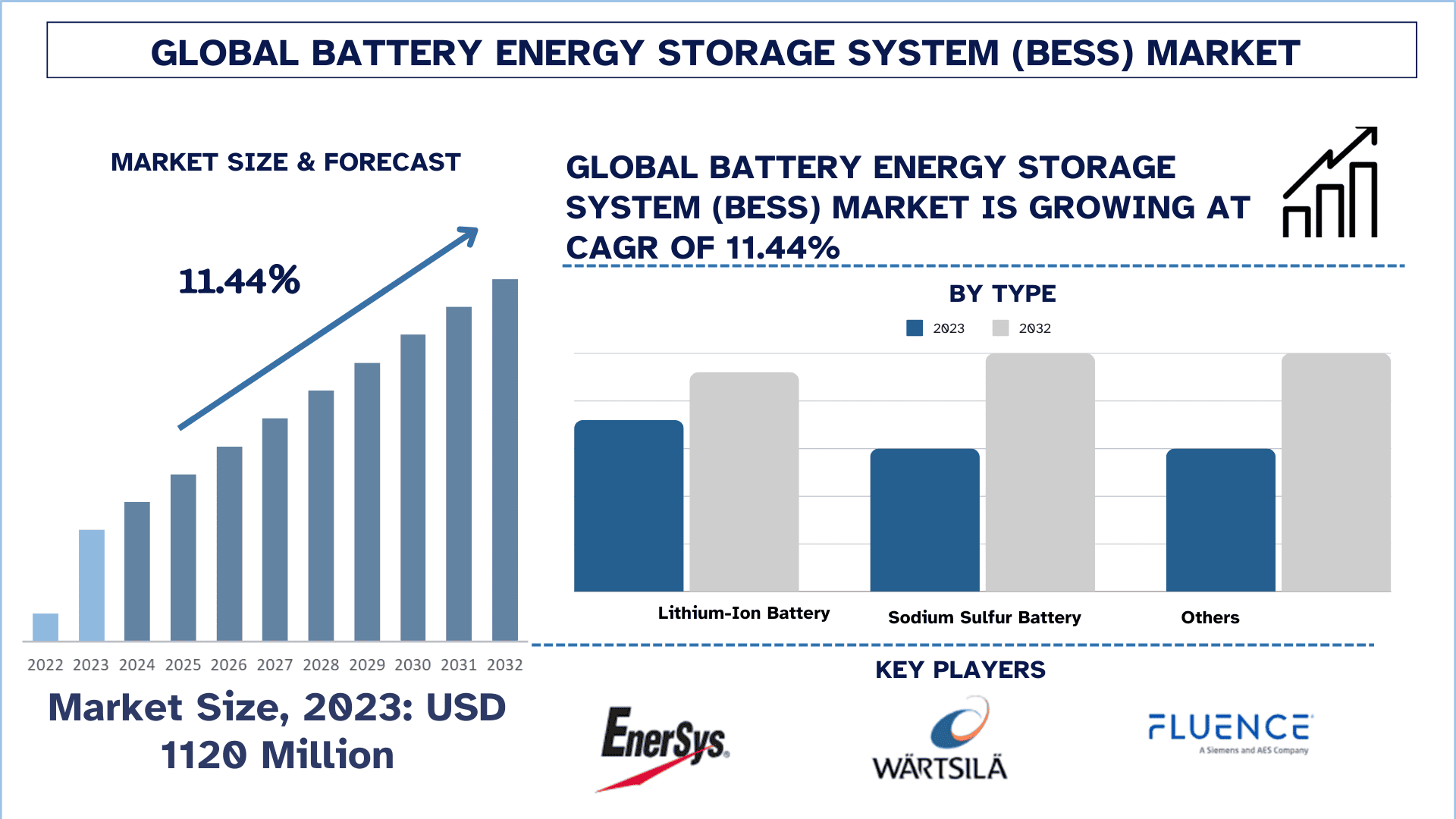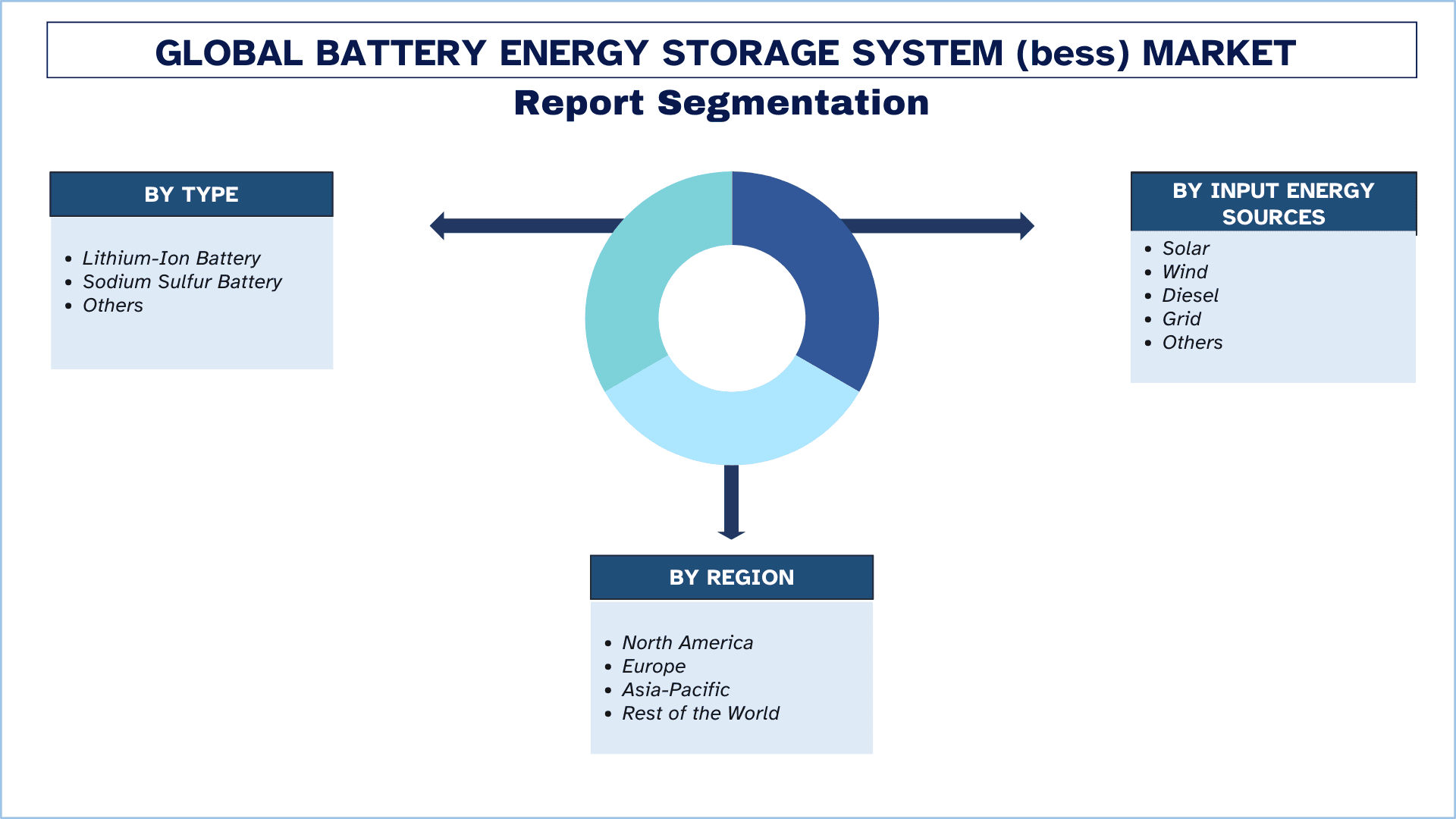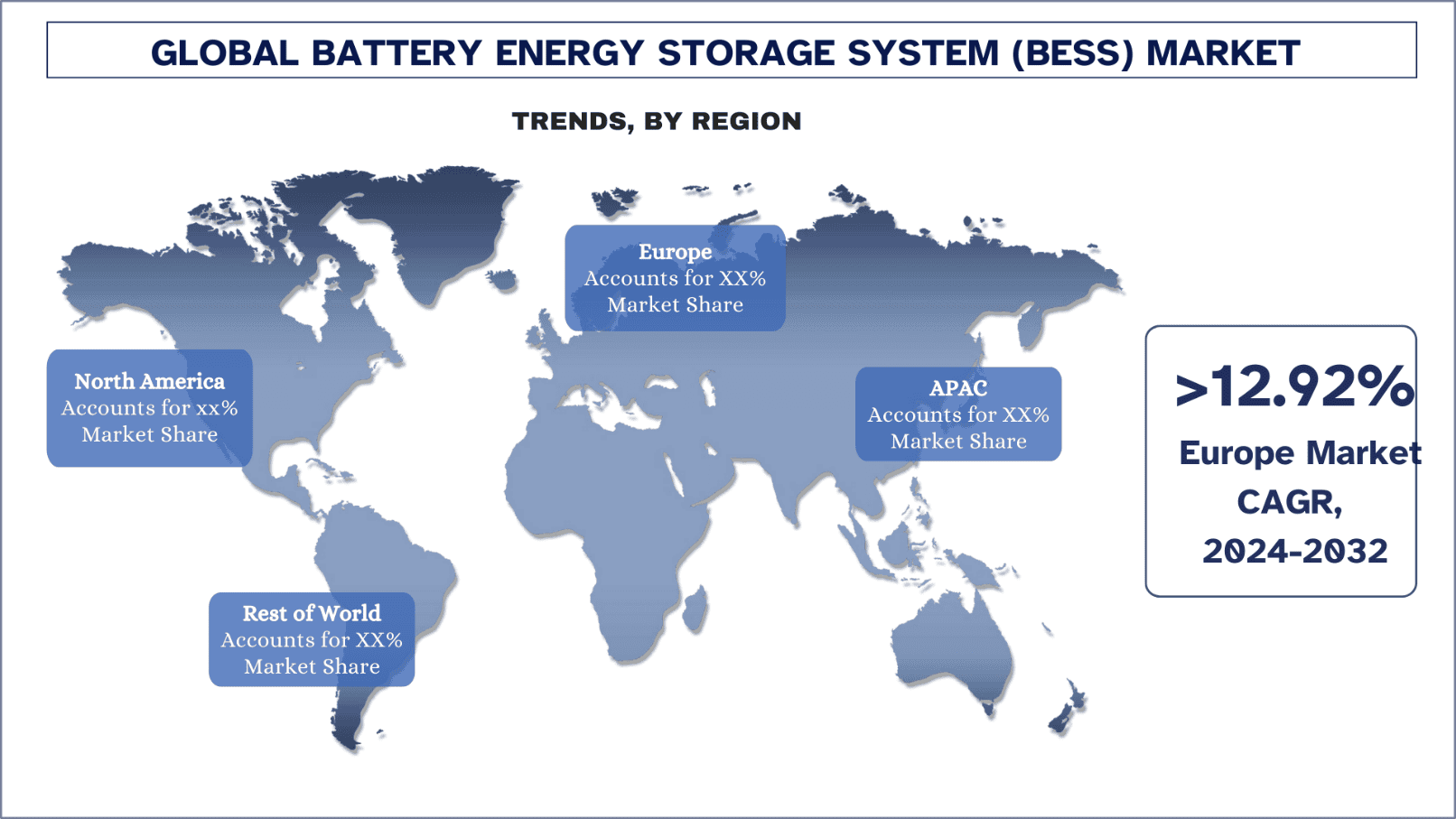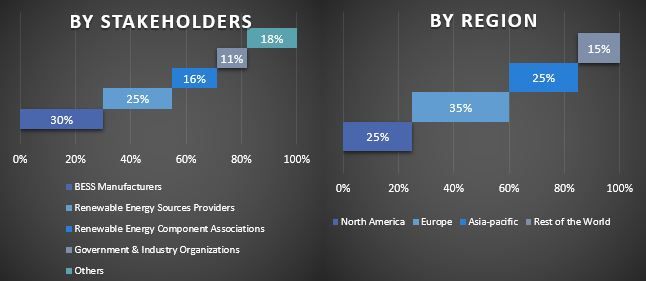- Home
- About Us
- Industry
- Services
- Reading
- Contact Us
Battery Energy Storage System (BESS) Market: Current Analysis and Forecast (2024-2032)
Emphasis on By Type (Lithium-Ion Battery, Sodium Sulfur Battery, Others); By Input Energy Sources (Solar, Wind, Diesel, Grid, Others), and Regions (North America (The US, Canada, Rest of North America), Europe (Germany, The UK, France, Italy, Spain, Rest of the Europe), Asia-pacific (China, Japan, India, Rest of the Asia-pacific), Rest of the World)

Global Battery Energy Storage System Market Size & Forecast
The Global Battery Energy Storage System Market was valued at USD 1120 million in 2023 and is expected to grow at a strong CAGR of around 11.44% during the forecast period (2024-2032) owing to rising demand for power delivering safety systems across the globe.
Global Battery Energy Storage System Market Analysis
The market for battery energy storage systems (BESS) has seen rapid transformative growth in response to the growing demand for renewable energy, stability in the grid, and backup power options. This technology stores energy produced from renewable sources such as solar and wind, as it becomes available, and provides for storage until it is needed - for example, when demand exceeds generation. It is driven by technological advancements in innovative battery technologies, government incentives, as well as the demand for improved grid resilience. Growing electric vehicle (EV) adoption combined with decarbonization will further accelerate that pace. The increasing relevance of BESS toward transforming energy infrastructure into sustainable and reliable systems will surely increase in future years.
The Global Battery Energy Storage System market was valued at USD 1120 million in 2023 and is expected to grow at a strong CAGR of around 11.44% during the forecast period (2024-2032). Global Battery Energy Storage System market has witnessed a rapid growth during 2022 and 2023 and is continue to exhibit a notable growth during the forecasted years. With the growing demand for power across the globe as well as rapid expansion of renewable energy power sources the Battery energy storage system solutions would further be implemented in order to store power and transmit it in case of peak shaving needs for residential and commercial purposes. Additionally, these systems also hep to transmit uninterrupted power supply to the systems in case of grid maintenance causes.
Government Policies & Regulations: Energy storage systems are promoted by legislations of governments and regulators. There are several incentives, subsidies, and mandates that encourage utilization of BESS, both by the utility and the industry. Considering the changes the demand for Battery Energy Storage System market would experience a rapid growth during 2024-2032.
Global Battery Energy Storage System Market Trends
This section discusses the key market trends that are influencing the various segments of the Global Battery Energy Storage System Market as identified by our team of research experts.
Hybrid Solutions (Solar + Storage)
Hybrid solutions that combine solar power generation with Battery Energy Storage Systems (BESS) are becoming increasingly popular. These systems enable consumers to harness the full potential of solar energy by storing excess power generated during sunny periods and using it when solar production is low, such as at night or during cloudy weather. This combination maximizes energy independence and reduces reliance on the grid, making solar power more reliable and consistent. In residential applications, hybrid solar-storage systems allow homeowners to decrease energy bills and increase resilience by providing backup power during outages. For commercial and industrial sectors, they offer a way to lower operational costs and improve energy security. As the cost of both solar panels and batteries continues to fall, the financial attractiveness of hybrid solutions grows, making them a viable option for more consumers. With governments offering incentives, the adoption of solar + storage hybrid systems is set to increase, driving further growth in the global BESS market.

Europe is Expected to Hold Major Market Share During Forecast Period
Europe Battery Energy Storage Systems (BESS) is growing at a very high pace primarily due to ambitious renewable energy targets and grid modernization efforts in the region, along with increased penetration of variable renewable energy sources such as wind and solar. Governments and regulatory bodies across Europe put in place policies aimed at decarbonizing the energy sector, which also goes in line with the European Green Deal in the context of net-zero emissions by 2050. This improves the investments in BESS to counterbalance issues such as grid stability, energy intermittency, and demand-supply mismatches.
The market is characterized by technological advancements primarily in lithium-ion construction, as they stand because they offer high energy density, low cost, and declining prices. Energy storage has now expanded into residential, commercial, and utility-sized applications, utility-scale holding the largest share for it plays an important role in grid services, such as frequency regulation, peak shaving, and renewable integration.
There are key players such as Fluence, Tesla, Wärtsilä, and Saft, which are extending their footprints in the region by providing innovative solutions to their partners as well as entering into strategic partnerships with them to take advantage of emerging demand. Some of the countries currently showing progress on this growth path include Germany, the UK, and France through attractive policies, subsidies, and trial programs. Moving ahead as an important part of energy transition, energy storage will determine the market growth in Europe for an indefinite period.

Global Battery Energy Storage System Market Overview
The Global Battery Energy Storage System market is competitive and fragmented, with the presence of several global and international market players. The key players are adopting different growth strategies to enhance their market presence, such as partnerships, agreements, collaborations, new product launches, geographical expansions, and mergers and acquisitions. Some of the major players operating in the market LG Energy Solution, Siemens Energy, Samsung SDI, Fluence, BYD, Contemporary Amperex Technology Co., Limited (CATL), Panasonic Industry Co., Ltd., Wärtsilä, Tesla, and EnerSys.
Global Battery Energy Storage System Market News
In 2024, government of India announced to install a 20 MW/40 MWh BESS installed which is anticipated to be installed within next 18 to 24 months (by 2026).
Global Battery Energy Storage System Market Report Coverage
Report Attribute | Details |
Base year | 2023 |
Forecast period | 2024-2032 |
Growth momentum | Accelerate at a CAGR of 11.44% |
Market size 2023 | USD 1120 million |
Regional analysis | North America, Europe, Asia-pacific, Rest of the World |
Major countries | The US, Canada, The UK, France, Germany, Italy, Spain, China, Japan, India |
Companies profiled | LG Energy Solution, Siemens Energy, Samsung SDI, Fluence, BYD, Contemporary Amperex Technology Co., Limited (CATL), Panasonic Industry Co., Ltd., Wärtsilä, Tesla, and EnerSys. |
Report Scope | Market Trends, Drivers, and Restraints; Revenue Estimation and Forecast; Segmentation Analysis; Demand and Supply Side Analysis; Competitive Landscape; Company Profiling |
Segments Covered | By Type, By Input Energy Sources, By Region/Country |
Reasons to buy this report:
The study includes market sizing and forecasting analysis validated by authenticated key industry experts.
The report presents a quick review of overall industry performance at one glance.
The report covers an in-depth analysis of prominent industry peers with a primary focus on key business financials, product portfolios, expansion strategies, and recent developments.
Detailed examination of drivers, restraints, key trends, and opportunities prevailing in the industry.
The study comprehensively covers the market across different segments.
Deep dive regional level analysis of the industry.
Customization Options:
The Global Battery Energy Storage System market can further be customized as per the requirement or any other market segment. Besides this, UMI understands that you may have your own business needs; hence, feel free to connect with us to get a report that completely suits your requirements.
Table of Content
Research Methodology for the Global Battery Energy Storage System Market Analysis (2024-2032)
Analyzing the historical market, estimating the current market, and forecasting the future market of the Global Battery Energy Storage System market were the three major steps undertaken to create and analyze the adoption of Global Battery Energy Storage System in major regions globally. Exhaustive secondary research was conducted to collect the historical market numbers and estimate the current market size. Secondly, to validate these insights, numerous findings and assumptions were taken into consideration. Moreover, exhaustive primary interviews were also conducted with industry experts across the value chain of the Global Battery Energy Storage System market. Post assumption and validation of market numbers through primary interviews, we employed a top-down/bottom-up approach to forecasting the complete market size. Thereafter, market breakdown and data triangulation methods were adopted to estimate and analyze the market size of segments and sub-segments of the industry. Detailed methodology is explained below:
Analysis of Historical Market Size
Step 1: In-Depth Study of Secondary Sources:
A detailed secondary study was conducted to obtain the historical market size of the Global Battery Energy Storage System market through company internal sources such as annual reports & financial statements, performance presentations, press releases, etc., and external sources including journals, news & articles, government publications, competitor publications, sector reports, third-party database, and other credible publications.
Step 2: Market Segmentation:
After obtaining the historical market size of the Global Battery Energy Storage System market, we conducted a detailed secondary analysis to gather historical market insights and share for different segments & sub-segments for major regions. Major segments are included in the report as by Type and by Input Energy Sources. Further regional/country-level analyses were conducted to evaluate the overall adoption of testing models in that region.
Step 3: Factor Analysis:
After acquiring the historical market size of different segments and sub-segments, we conducted a detailed factor analysis to estimate the current market size of the Global Battery Energy Storage System market. Further, we conducted factor analysis using dependent and independent variables such as by Type and by Input Energy Sources in the Global Battery Energy Storage System market. A thorough analysis was conducted for demand and supply-side scenarios considering top partnerships, mergers and acquisitions, business expansion, and product launches in the Global Battery Energy Storage System market sector across the globe.
Current Market Size Estimate & Forecast
Current Market Sizing: Based on actionable insights from the above 3 steps, we arrived at the current market size, key players in the Global Battery Energy Storage System market, and market shares of the segments. All the required percentage shares split and market breakdowns were determined using the above-mentioned secondary approach and verified through primary interviews.
Estimation & Forecasting: For market estimation and forecast, weights were assigned to different factors, including drivers & trends, restraints, and opportunities available for the stakeholders. After analyzing these factors, relevant forecasting techniques, i.e., the top-down/bottom-up approach, were applied to arrive at the market forecast for 2032 for different segments and sub-segments across the major markets globally. The research methodology adopted to estimate the market size encompasses:
The industry’s market size, in terms of revenue (USD) and the adoption rate of the Global Battery Energy Storage System market across the major markets domestically
All percentage shares, splits, and breakdowns of market segments and sub-segments
Key players in the Global Battery Energy Storage System market in terms of products offered. Also, the growth strategies adopted by these players to compete in the fast-growing market.
Market Size and Share Validation
Primary Research: In-depth interviews were conducted with the Key Opinion Leaders (KOLs), including Top Level Executives (CXO/VPs, Sales Head, Marketing Head, Operational Head, Regional Head, Country Head, etc.) across major regions. Primary findings were then summarized, and statistical analysis was performed to prove the stated hypothesis. Inputs from primary research were consolidated with secondary findings, hence turning information into actionable insights.
Split of Primary Participants in Different Regions
Market Engineering
The data triangulation technique was employed to complete the overall market estimation and to arrive at precise statistical numbers for each segment and sub-segment of the Global Battery Energy Storage System market. Data was split into several segments and sub-segments after studying various parameters and trends by Type and by Input Energy Sources in the Global Battery Energy Storage System market.
The main objective of the Global Battery Energy Storage System Market Study
The current & future market trends of the Global Battery Energy Storage System market were pinpointed in the study. Investors can gain strategic insights to base their discretion for investments on the qualitative and quantitative analysis performed in the study. Current and future market trends determined the overall attractiveness of the market at a regional level, providing a platform for the industrial participant to exploit the untapped market to benefit from a first-mover advantage. Other quantitative goals of the studies include:
Analyze the current and forecast market size of the Global Battery Energy Storage System market in terms of value (USD). Also, analyze the current and forecast market size of different segments and sub-segments.
Segments in the study include areas by Type and by Input Energy Sources.
Define and analyze the regulatory framework for global Battery Energy Storage System industry.
Analyze the value chain involved with the presence of various intermediaries, along with analyzing customer and competitor behaviors of the industry.
Analyze the current and forecast market size of the Global Battery Energy Storage System market for the major regions.
Major countries of regions studied in the report include North America (The US, Canada, and Rest of North America), Europe (The UK, France, Germany, Italy, Spain, Rest of Europe), Asia-pacific (China, Japan, India, Rest of the Asia-pacific), Rest of the World
Company profiles of the Global Battery Energy Storage System market and the growth strategies adopted by the market players to sustain in the fast-growing market.
Deep dive regional level analysis of the industry.
Frequently Asked Questions FAQs
Q1: What is the current market size and growth potential of the global battery Energy Storage System market?
The global battery energy storage system market was valued at USD 1120 Million in 2023 and is expected to grow at a CAGR of 11.44% during the forecast period (2024-2032).
Q2: What is the driving factor for the growth of the global battery energy storage system market?
Renewable energy integration and conducive government policies are some of the key driving factors for growth.
Q3: Which segment has the largest share of the global battery energy storage system market by type?
The lithium-ion battery segment has the largest share of the Global Battery Energy Storage System market by type.
Q4: Which region will dominate the global battery energy storage system market?
Europe is expected to dominate the market during the forecast period.
Related Reports
Customers who bought this item also bought











